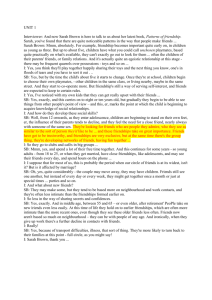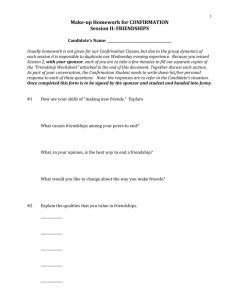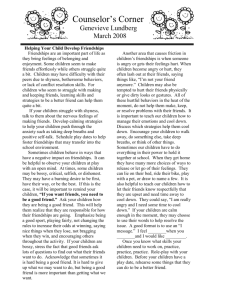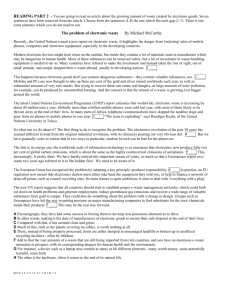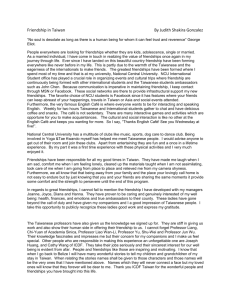Summary Notes - North Carolina Early Learning Network
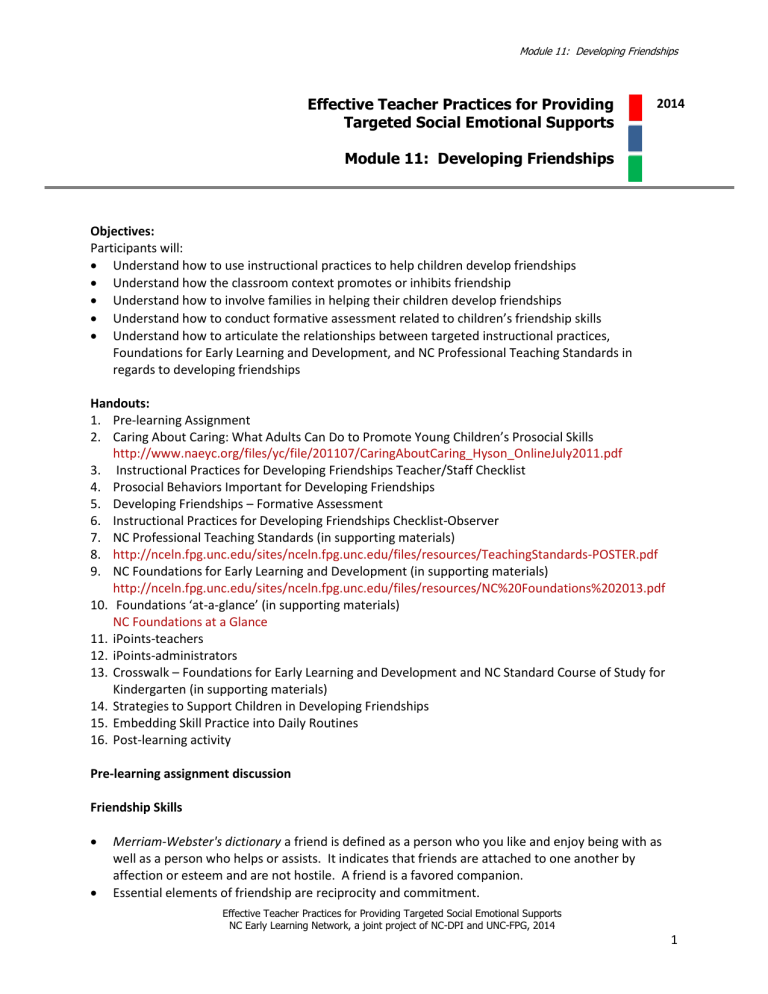
Module 11: Developing Friendships
Effective Teacher Practices for Providing
Targeted Social Emotional Supports
Module 11: Developing Friendships
2014
Objectives:
Participants will:
Understand how to use instructional practices to help children develop friendships
Understand how the classroom context promotes or inhibits friendship
Understand how to involve families in helping their children develop friendships
Understand how to conduct formative assessment related to children’s friendship skills
Understand how to articulate the relationships between targeted instructional practices,
Foundations for Early Learning and Development, and NC Professional Teaching Standards in regards to developing friendships
Handouts:
1.
Pre-learning Assignment
2.
Caring About Caring: What Adults Can Do to Promote Young Children’s Prosocial Skills http://www.naeyc.org/files/yc/file/201107/CaringAboutCaring_Hyson_OnlineJuly2011.pdf
3.
Instructional Practices for Developing Friendships Teacher/Staff Checklist
4.
Prosocial Behaviors Important for Developing Friendships
5.
Developing Friendships – Formative Assessment
6.
Instructional Practices for Developing Friendships Checklist-Observer
7.
NC Professional Teaching Standards (in supporting materials)
8.
http://nceln.fpg.unc.edu/sites/nceln.fpg.unc.edu/files/resources/TeachingStandards-POSTER.pdf
9.
NC Foundations for Early Learning and Development (in supporting materials) http://nceln.fpg.unc.edu/sites/nceln.fpg.unc.edu/files/resources/NC%20Foundations%202013.pdf
10.
Foundations ‘at-a-glance’ (in supporting materials)
NC Foundations at a Glance
11.
iPoints-teachers
12.
iPoints-administrators
13.
Crosswalk – Foundations for Early Learning and Development and NC Standard Course of Study for
Kindergarten (in supporting materials)
14.
Strategies to Support Children in Developing Friendships
15.
Embedding Skill Practice into Daily Routines
16.
Post-learning activity
Pre-learning assignment discussion
Friendship Skills
Merriam-Webster's dictionary a friend is defined as a person who you like and enjoy being with as well as a person who helps or assists. It indicates that friends are attached to one another by affection or esteem and are not hostile. A friend is a favored companion.
Essential elements of friendship are reciprocity and commitment.
Effective Teacher Practices for Providing Targeted Social Emotional Supports
NC Early Learning Network, a joint project of NC-DPI and UNC-FPG, 2014
1
Module 11: Developing Friendships
Around the age of 7-8 children begin to realize that friendships are personal and may be based on common interests (Gurian, 2012).
Jot down 3-5 characteristics you would consider important in making friends. Also consider what the short-term and/or long-term outcomes might be for these children.
Why friendship skills are important
The single best childhood predictor of adult adaptation is not school grades, and not classroom behavior, but rather, the adequacy with which the child gets along with other children.
-Willard Hartup, President of International Society
for the Study of Behavioral Development
Research suggests that young children who learn positive social skills are more likely to have positive relationships, acceptance, and friendships later on in school and as adults (Eisenberg et al. 1991).
A recent Head Start study showed that children scoring higher on prosocial competence were determined later in the year to be the most “cognitively ready” for school (Bierman et al. 2009).
Reciprocity and Lengthy Encounters are key
Successful social interactions also provide a context for our English Language Learners to become proficient in their new language (Tabors, 1997).
The Division of Early Childhood (DEC) Recommended Practices in Early Intervention/Early Childhood
Special Education (2014) “provide guidance to practitioners and families about the most effective ways to improve learning outcomes and promote development of young children, birth through five years of age, who have or are at-risk for developmental delays or disabilities.”
What prosocial behaviors are important for developing friendships?
There are several discrete behaviors that young children engage in during play with each other that seem to be directly related to having friends (Tremblay et al., 1981).
Formative Assessment
Take a few minutes to read through the descriptions for each behavior in the handout Prosocial
Behaviors Important for Developing Friendships.
Effective Teacher Practices for Providing Targeted Social Emotional Supports
NC Early Learning Network, a joint project of NC-DPI and UNC-FPG, 2014
2
Module 11: Developing Friendships
Write a definition of target skill (clear learning targets), list characteristics of target skill, list examples and non-examples (define criterion for success), list evidences that can be used to determine progress in this area (collect and analyze evidence) and note descriptive, positive feedback you might provide for this skill. Also note any instances you can think of that might require you to change or adjust your instruction. Document your work on handout Developing Friendships – Formative Assessment.
Instructional Practices Checklist
Items on the Instructional Practices for Developing Friendships Observer Checklist have been adapted from the Center on the Social and Emotional Foundations for Early Learning (CSEFEL) and the University of Iowa. The checklist items are part of the Teaching Pyramid Observation Tool or TPOT. The SEFEL
(Social and Emotional Foundations for Early Learning) project has recognized that this information is research-based and shown to be effective in helping children learn.
Video of Lisa promoting prosocial behavior in the block center
At the time of the videotaping this classroom included 17 children age three to five. Four of the children were identified as Exceptional Children: three as Developmental Delay and one as Speech Impaired.
Several children were identified with social emotional needs in the classroom including five children who had been referred for play therapy due to severe emotional trauma. One child was a Dual Language
Learner. The classroom staff included one teacher and two assistants. At the time of the videotaping an additional support person was working in the classroom. One of the students you will see in the video was new to the classroom and had exhibited many extreme physically aggressive behaviors. The other child was identified as having significant delays.
Look for the practices listed on the Instructional Practices for Developing Friendships Observer Checklist.
NC Professional Teaching Standards
Now pull out the handout that lists our NC Professional Teaching Standards. Which teaching standard(s) did the teacher demonstrate?
Foundations
Foundations are organized around five different developmental domains. But we know that children integrate skills from across areas of development to participate in day-to-day activities. What standards were addressed as the teacher guided the children to work out their differences in the block center? iPoints
‘Instructional Practices Observed IN Teaching Standards’
Effective Teacher Practices for Providing Targeted Social Emotional Supports
NC Early Learning Network, a joint project of NC-DPI and UNC-FPG, 2014
3
Module 11: Developing Friendships
iPoints for teachers are meant to facilitate teacher self-reflection on the connection between practices, early learning and development standards, and teaching standards.
iPoints for administrators is meant to help them see the connections when they observe a preschool classroom.
Crosswalks
Crosswalks show how the early learning and development standards align with the NC Standard
Course of Study (NC Essential Standards and the Common Core).
The crosswalk is meant to show that when we help children work on Language Development and
Communication goal 2: Children participate in conversations with peers and adults in one-on-one, small, and larger group interactions we are working on the Common Core Speaking and Listening
Standards for kindergarten goal 1: Participate in collaborative conversations with diverse partners about kindergarten topics and texts with peers and adults in small and larger groups by following agreed upon rules for discussions.
Family Involvement
As noted in DEC Recommended Practices (2014), teachers should “provide the family with up-todate, comprehensive and unbiased information in a way that the family can understand and use to make informed choices and decisions.”
We support families in helping children develop friendships by sharing relevant research information with them.
Research indicates that when parents are explicit about the type of behavior they expect to see, then children do in fact become more helpful and caring than if expectations are not clear
(Eisenberg et al., 2006).
Other research indicates that offering rewards for “being nice” does not lead to improved prosocial behavior but may cause children to become less generous when the rewards are taken away
(Warneken & Tomasello, 2008).
Many cultures emphasize the importance of sharing and working together within the family and community (Hyson & Taylor, 2011).
Setting the stage
DEC Recommended Practices (2014) Environment Practice 3 \ states, “Practitioners work with family and other adults to modify and adapt the physical (e.g. space, equipment, and materials), social (e.g. interactions with peers, siblings and family members), and temporal (e.g. sequence and length of routines and activities) environments to promote each child’s access to and participation in learning experiences.”
An inclusive environment where all children are meaningfully included in natural proportions is critical to setting the stage for friendships (Guralnick, 1990).
Effective Teacher Practices for Providing Targeted Social Emotional Supports
NC Early Learning Network, a joint project of NC-DPI and UNC-FPG, 2014
4
Module 11: Developing Friendships
Dr. Cole Galloway, Program Director of Go Baby Go, has developed guidelines for modifying off-theshelf ride-on cars to increase exploration of kids with special needs (video).
Gillanders (2007) describes one mono-lingual English-speaking teacher’s effort to build social connection between Spanish-speaking and English-speaking peers. This teacher initiated the process of learning Spanish by enrolling in classes, listening to CDs, and playing games on the internet. She then began using her limited Spanish vocabulary as well as other Spanish materials to interact with students in her classroom, creating an environment that valued the use of the Spanish language. As a result, “speaking Spanish became a desirable skill” which increased the “Latino children’s social status among their peers.”
Teachers can also help by including social interaction goals on the IEP. Although these goals are likely to be the most critical for the child’s later development, they often do not appear on IEPs or
IFSPs (Odom, McConnell, & McEvoy, 1992), perhaps because many assessments do not include these skills as test items
Cooperative use of toys and materials
What types of cooperative use toys do you have in your classroom?
Planning to intentionally teach friendship skills
Plan time to teach friendships skills just as you would literacy, math or any other skill.
Design a flexible schedule which allows children to become invested in partnership activities, plan time for cooperative activities (activities that require at least 2 people) and use Peer Buddies during centers.
Take advantage of naturally occurring moments throughout the day when teachers can intentionally embed instruction around friendship development into almost any part of the daily schedule.
Creating a friendly environment
Adults giving time and attention to children, adults talking nicely to one another, and children supporting one another’s friendly behavior.
Strategies to Support Children in Developing Friendships
Read and discuss handout: Strategies to Support Children in Developing Friendships.
What strategies are you currently using to teach friendship skills?
What other strategies might benefit the children in your classroom including those children with exceptionalities such as those with autism, cerebral palsy, hearing impairment, vision impairment or learning English as a second language?
How can you embed instruction into daily activities and how planning with related service personnel?
Effective Teacher Practices for Providing Targeted Social Emotional Supports
NC Early Learning Network, a joint project of NC-DPI and UNC-FPG, 2014
5
Module 11: Developing Friendships
Create a Friendship-Building Activity
Reviewing instructional practices checklist, NC Teaching Standards document and Foundations:
What practices would be addressed by implementing the activity you created in your classroom?
What is the evidence for each of the practices you selected?
What teaching standards are addressed by planning and implementing the activity?
What are the children participating in these activities doing as it relates to the NC Foundations for
Early Learning and Development?
Crosswalk
What kindergarten skills would the activity you created address?
Planning for Implementation
Identify one friendship skill you would like to target in your classroom listed on the handout Embedding
Skill Practice into Daily Routines.
What strategies can you use throughout the day to intentionally teach the friendship skill you identified?
How can you share this information with other teaching staff and parents?
Questions
Post-learning Activities
References
Chang, F., Crawford, G., Early, D., Bryant, D., Howes, C., Burchinal, M., Barbarin, O., Clifford, R., and
Pianta, R. (2007). Spanish-speaking children’s social and language development in prekindergarten classrooms. Early Education and Development, 18(2), 243-269.
CONNECT: The Center to Mobilize Early Childhood Knowledge. (n.d.). CONNECT modules. Module 4:
Family-Professional Partnerships. Retrieved from http://community.fpg.unc.edu/connectmodules/learners/module-4
Effective Teacher Practices for Providing Targeted Social Emotional Supports
NC Early Learning Network, a joint project of NC-DPI and UNC-FPG, 2014
6
Module 11: Developing Friendships
Division for Early Childhood. (2014). DEC recommended practices in early intervention/early childhood special education 2014. Retrieved from http://www.dec-sped.org/recommendedpractices
Eisenberg, N., Fabes, R. A. and Spinrad, T. L. (2006). Handbook of Child Psychology, Social, Emotional,
and Personality Development, Sixth Edition. Hoboken, NJ: John Wiley & Sons.
Gillanders, C. (2007). An English-speaking prekindergarten teacher for young Latino children:
Implications of the teacher-child relationship on second language learning. Early Childhood
Education Journal, 35(1), 47-54.
Guralnick, M.J. (1990). Peer interactions and the development of handicapped children’s social and communicative competence. In H. Foot, M. Morgan, & R. Shute (Eds.), Children Helping Children pp.275-305). Sussex, England: John Wiley & Sons.
Gurian, A. (2012, August). Friends and Friendships. Retrieved from http://www.aboutourkids.org/articles/friends_friendships
Hartup, W. W. (1992). Having friends, making friends, and keeping friends: Relationships as educational contexts. ERIC Digest [Online]. Retrieved from http://ericeece.org/pubs/digests/
1992/hartup92.html
Hemmeter, M. L., Fox, L. K., & Snyder, P. (2014). Teaching Pyramid Observation Tool (TPOT™) for
Preschool Classrooms Manual, Research Edition. Baltimore, MD: Brookes Publishing Company.
Hyson, M., & Taylor, J. L. (2011). Caring about caring: What adults can do to promote young children’s prosocial skills. Young Children, 66(4). Retrieved from http://www.naeyc.org/files/yc/file/201107/CaringAboutCaring_Hyson_OnlineJuly2011.pdf
Iowa State University Department of Human Development & Family Studies. (2013). Train-Coach-Train.
Retrieved from https://iastate.app.box.com/s/9rg5sxh5mfh43da7e05k
NationSwell. [NationSwell]. (2014, February 12). How One Man's Trip to Toys 'R' Us Brought Mobility to
Hundreds of Disabled Kids [Video file]. Retrieved from https://www.youtube.com/watch?v=U-
NE7B0RTdA
North Carolina Department of Public Instruction. (2012). North Carolina Teacher Evaluation Process.
Retrieved from http://www.ncpublicschools.org/docs/effectivenessmodel/ncees/instruments/teach-eval-manual.pdf
North Carolina Foundations Task Force. (2013). North Carolina foundations for early learning and development. Retreived from http://ncchildcare.nc.gov/pdf_forms/NC_foundations.pdf
Odom, S.L., McConnell, S.R., McEvoy, M.A. (Eds.) (1992). Social competence of young children with
disabilities: Issues and strategies for intervention. Baltimore, MD: Paul H. Brookes.
Smith, C. A. (2013). Beyond “I’m sorry”: The educator’s role in preschoolers’ emergence of conscience.
Young Children, 68 (1): 76-82.
Effective Teacher Practices for Providing Targeted Social Emotional Supports
NC Early Learning Network, a joint project of NC-DPI and UNC-FPG, 2014
7
Module 11: Developing Friendships
Tremblay, A., Strain, P.S., Hendrickson, J.M., & Shores, R.E. (1981). Social interactions of normal preschool children. Behavior Modification, 5, 237-253.
Warneken, F. & Tomasello, M. (2008). Extrinsic rewards undermine altruistic tendencies in 20-montholds. Developmental Psychology, 44 (6): 1785-88.
Effective Teacher Practices for Providing Targeted Social Emotional Supports
NC Early Learning Network, a joint project of NC-DPI and UNC-FPG, 2014
8

